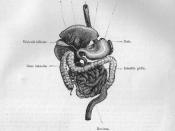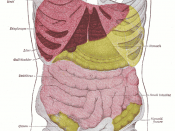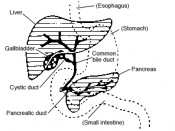Introduction
The dissection of the fetal pig in the laboratory is important because pigs and humans have the same level of metabolism and have similar organs and systems. Also, fetal pigs are a byproduct of the pork food industry so they aren't raised for dissection purposes, and they are relatively inexpensive.
Procedure - as in the text book
Purpose:
The purpose of such activity is to dissect the fetal pig and observe various organs.
Materials:
Safety goggles
String
Dissecting pins
Lab apron
Scalpel
Scissors
Dissecting gloves
Hand lens
Ruler
Preserved Pig
Dissecting Tray
Forceps and probe
Observations
Using a ruler, measure the length of the pig from the snout to the tail. Use graph to estimate the age of the fetal pig.
30cm = 12 days old
Locate the liver near the anterior of the abdominal cavity. Record the number of lobes in the liver
4 Lobes
Describe the location of gall bladder Underneath right lobe, grey/white color
Describe the appearance of the pancreas Creamy - white, tubular
Describe the appearance of the inner lining of the stomach Wavy long rides with circular endings
List the organs found in the thoracic cavity Larynx, trachea, heart, left lung, esophagus, left kidney, aorta, bladder, umbilical cord, urogenital opening, penis, scrotal sac, rectum, ureter, right kidney, inferior vena cava, umbilical vein, hepatic veins, right lung, thyroid gland
Blood is pumped from the left atrium to the left ventricle and out the aorta Ventricle - thicker
Atrium - thiner
Place your index finger on the trochea and push down.
Describe what happens. Liquid gushes out
Analysis
What is the function of the umbilical cord?
The flexible cordlike structure connecting a fetus at the abdomen with the placenta and containing two umbilical arteries and one vein that transport nourishment to the fetus and...


